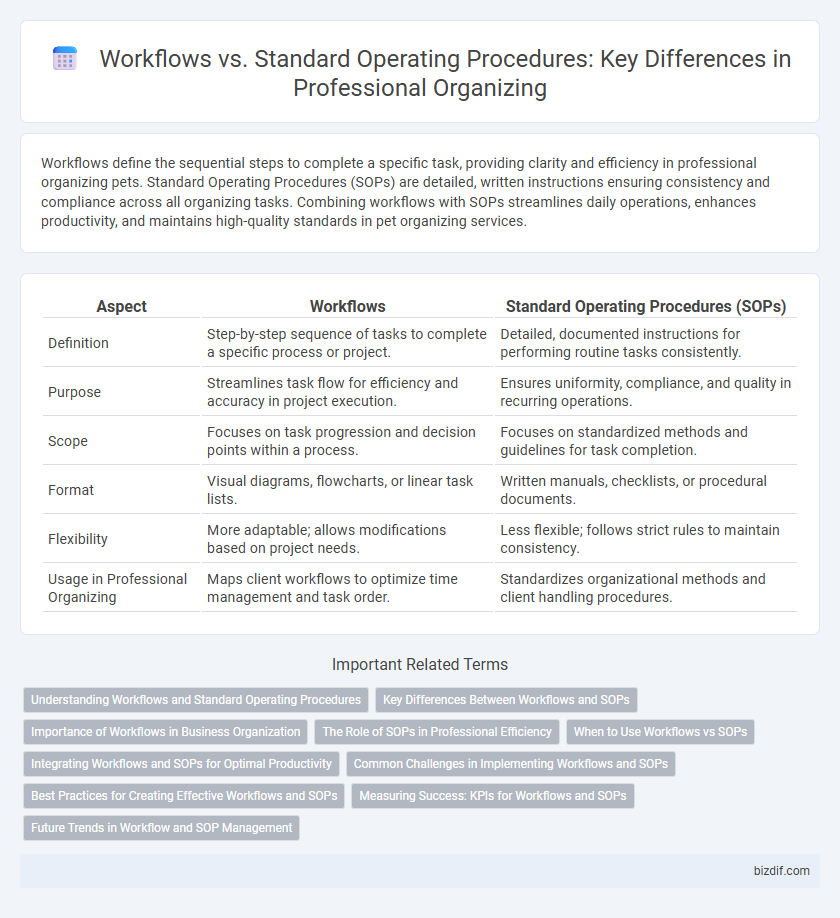Workflows define the sequential steps to complete a specific task, providing clarity and efficiency in professional organizing pets. Standard Operating Procedures (SOPs) are detailed, written instructions ensuring consistency and compliance across all organizing tasks. Combining workflows with SOPs streamlines daily operations, enhances productivity, and maintains high-quality standards in pet organizing services.
Table of Comparison
| Aspect | Workflows | Standard Operating Procedures (SOPs) |
|---|---|---|
| Definition | Step-by-step sequence of tasks to complete a specific process or project. | Detailed, documented instructions for performing routine tasks consistently. |
| Purpose | Streamlines task flow for efficiency and accuracy in project execution. | Ensures uniformity, compliance, and quality in recurring operations. |
| Scope | Focuses on task progression and decision points within a process. | Focuses on standardized methods and guidelines for task completion. |
| Format | Visual diagrams, flowcharts, or linear task lists. | Written manuals, checklists, or procedural documents. |
| Flexibility | More adaptable; allows modifications based on project needs. | Less flexible; follows strict rules to maintain consistency. |
| Usage in Professional Organizing | Maps client workflows to optimize time management and task order. | Standardizes organizational methods and client handling procedures. |
Understanding Workflows and Standard Operating Procedures
Workflows represent the sequential steps and processes required to complete specific tasks within a project, outlining the flow of activities and decision points. Standard Operating Procedures (SOPs) provide detailed, standardized instructions to ensure consistency and compliance across repetitive tasks. Understanding the distinction between workflows and SOPs enhances efficiency by clarifying task execution and maintaining quality control in professional organizing systems.
Key Differences Between Workflows and SOPs
Workflows map the step-by-step sequence of tasks to complete a process, emphasizing the flow and order of activities, while Standard Operating Procedures (SOPs) provide detailed, written instructions outlining how to perform specific tasks consistently. Workflows highlight the overall process structure and dependencies between steps, whereas SOPs focus on ensuring uniformity, compliance, and quality control in task execution. Understanding these key differences helps professional organizers design efficient systems that balance clarity and flexibility for improved productivity.
Importance of Workflows in Business Organization
Workflows streamline business operations by clearly defining task sequences and responsibilities, ensuring consistency and efficiency. They reduce errors, improve communication, and enable scalability by providing a visual roadmap for project execution. Implementing effective workflows enhances productivity and supports seamless coordination across teams, leading to better organizational outcomes.
The Role of SOPs in Professional Efficiency
Standard Operating Procedures (SOPs) establish consistent, step-by-step guidelines that streamline workflows and reduce errors in professional organizing. By formalizing routine tasks, SOPs enhance productivity, ensure quality control, and facilitate training for new team members. Implementing well-documented SOPs leads to improved efficiency and scalable organizational systems.
When to Use Workflows vs SOPs
Workflows are ideal for visualizing and managing sequential tasks that require collaboration across multiple team members, enhancing process clarity and efficiency. Standard Operating Procedures (SOPs) are essential for detailed, step-by-step instructions to ensure consistency, compliance, and quality control in repetitive or regulated tasks. Use workflows to streamline dynamic processes with dependencies, and SOPs for standardized tasks requiring clear documentation and training.
Integrating Workflows and SOPs for Optimal Productivity
Integrating workflows and standard operating procedures (SOPs) streamlines tasks and enhances consistency in professional organizing. Workflows map the sequence of activities, while SOPs provide detailed instructions for each step, ensuring clarity and quality control. Combining these tools optimizes productivity by reducing errors and improving time management during organizing projects.
Common Challenges in Implementing Workflows and SOPs
Common challenges in implementing workflows and standard operating procedures (SOPs) include resistance to change from employees, lack of clear communication, and inadequate training resources. Many organizations struggle with maintaining consistency and ensuring compliance due to poorly defined roles and responsibilities within workflows and SOPs. Technical difficulties integrating new processes into existing systems further hinder smooth implementation and reduce overall efficiency.
Best Practices for Creating Effective Workflows and SOPs
Effective workflows and standard operating procedures (SOPs) enhance productivity by clearly defining tasks and responsibilities in professional organizing. Best practices for creating these include mapping out each step in detail, incorporating feedback from team members, and regularly reviewing processes for continuous improvement. Utilizing visual tools and templates ensures consistency and clarity, minimizing errors and streamlining organizational efficiency.
Measuring Success: KPIs for Workflows and SOPs
Measuring success in workflows and Standard Operating Procedures (SOPs) requires specific Key Performance Indicators (KPIs) tailored to each process. Workflow KPIs often include cycle time, task completion rate, and error frequency, reflecting efficiency and task accuracy. SOP KPIs focus on compliance rate, consistency in execution, and reduction in training time, ensuring standardized operations and quality control.
Future Trends in Workflow and SOP Management
Future trends in workflow and SOP management emphasize increased integration of AI-driven automation and real-time analytics to enhance efficiency and adaptability in professional organizing. Cloud-based platforms are enabling seamless collaboration and continuous updates, ensuring that workflows and SOPs remain dynamic and responsive to evolving organizational needs. Enhanced user experience with customizable templates and mobile accessibility is driving greater adoption and consistent application across teams.
Workflows vs Standard Operating Procedures Infographic

 bizdif.com
bizdif.com